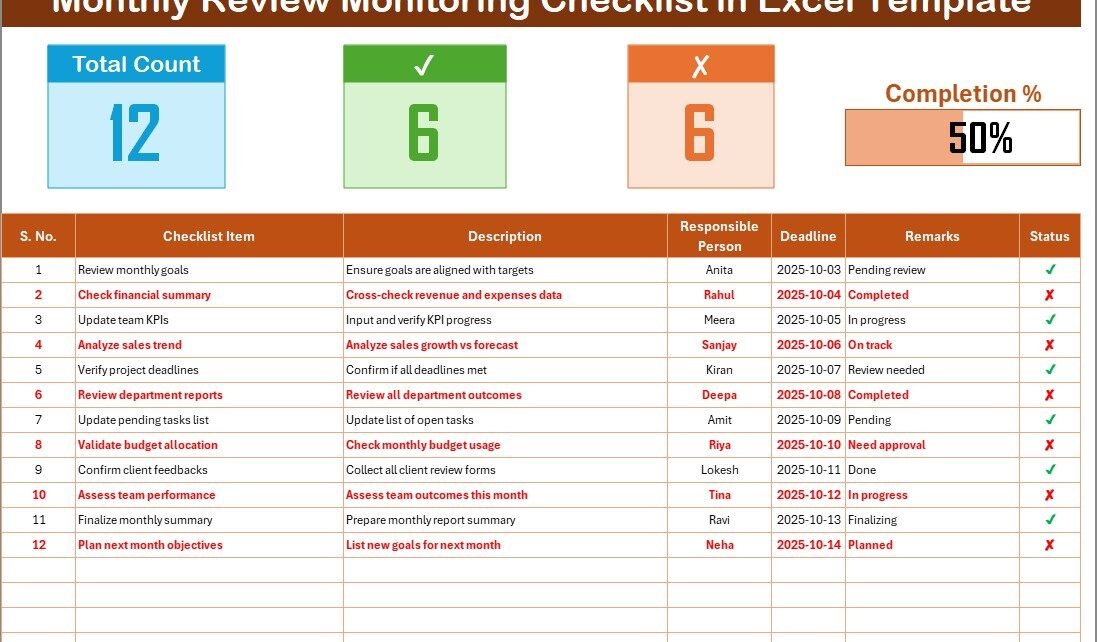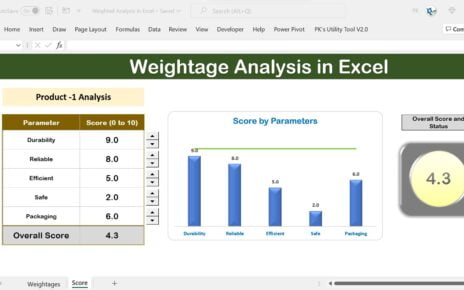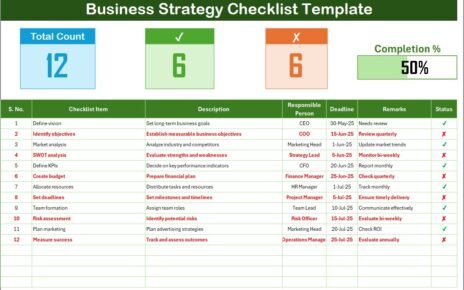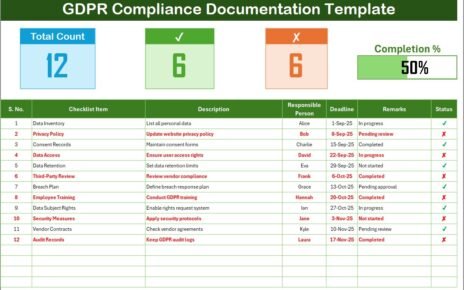In today’s fast-paced professional world, regular reviews are essential to keep projects, departments, and personal goals on track. A well-structured Monthly Review Monitoring Checklist in Excel can transform how you track progress, identify issues, and improve accountability.
Whether you manage a business, a team, or personal tasks, this checklist template simplifies monthly performance monitoring and ensures nothing slips through the cracks. Let’s explore how this template works, its structure, and how you can implement it effectively for measurable results.
Click to buy Monthly Review Monitoring Checklist in Excel
What Is a Monthly Review Monitoring Checklist in Excel?
A Monthly Review Monitoring Checklist is a systematic tool designed to help you evaluate progress, track tasks, and maintain control over key deliverables each month.
Instead of scattered notes or unorganized spreadsheets, this Excel-based checklist gives you a clear view of what has been completed, what’s pending, and who is responsible for each activity. It acts as your digital review assistant, allowing you to plan, assess, and improve monthly performance in one place.
Excel’s built-in formulas, conditional formatting, and automation capabilities make it the perfect platform for such checklists. It provides real-time progress tracking through visual indicators like percentage bars, color codes, and completion summaries.
Why Use Excel for Monthly Review Monitoring?
Microsoft Excel remains one of the most flexible tools for planning, monitoring, and analysis. With minimal setup, you can build an advanced monitoring system that works exactly the way you want. Here’s why Excel is a great choice:
- Easy Customization: Add or remove checklist items anytime.
- Automated Progress Tracking: Use formulas to calculate completion rates automatically.
- Accountability: Assign responsibilities to individuals using dropdown lists.
- Reusability: Copy the template each month to track performance trends.
- Visual Insights: Incorporate progress bars and charts to monitor monthly achievements.
Using Excel means you don’t need any coding or software licenses — just structured data and smart formulas.
Structure of the Monthly Review Monitoring Checklist Template
The Monthly Review Monitoring Checklist in Excel consists of two main worksheets:
Checklist Sheet Tab (Main Sheet)
List Sheet Tab (Supporting Sheet)
Each part has a specific purpose, making the overall design simple yet effective.
1. Main Checklist Sheet Tab
This is the heart of your template — where you record all review items and monitor their completion status.
Top Section Overview
At the top of the sheet, you’ll find summary cards that display overall progress at a glance.
These cards include:
- Total Count: The total number of checklist items for the month.
- Completed Count: The number of items marked as complete.
- Pending Count: The number of items still in progress or not done.
- Progress Bar: A dynamic bar that visually shows your completion percentage.
This section updates automatically based on the data in the checklist table below. It gives instant insight into how well your month’s activities are progressing.
You can apply conditional formatting to highlight completed tasks in green and pending ones in red.
This color-coded visualization makes monitoring easy and quick.
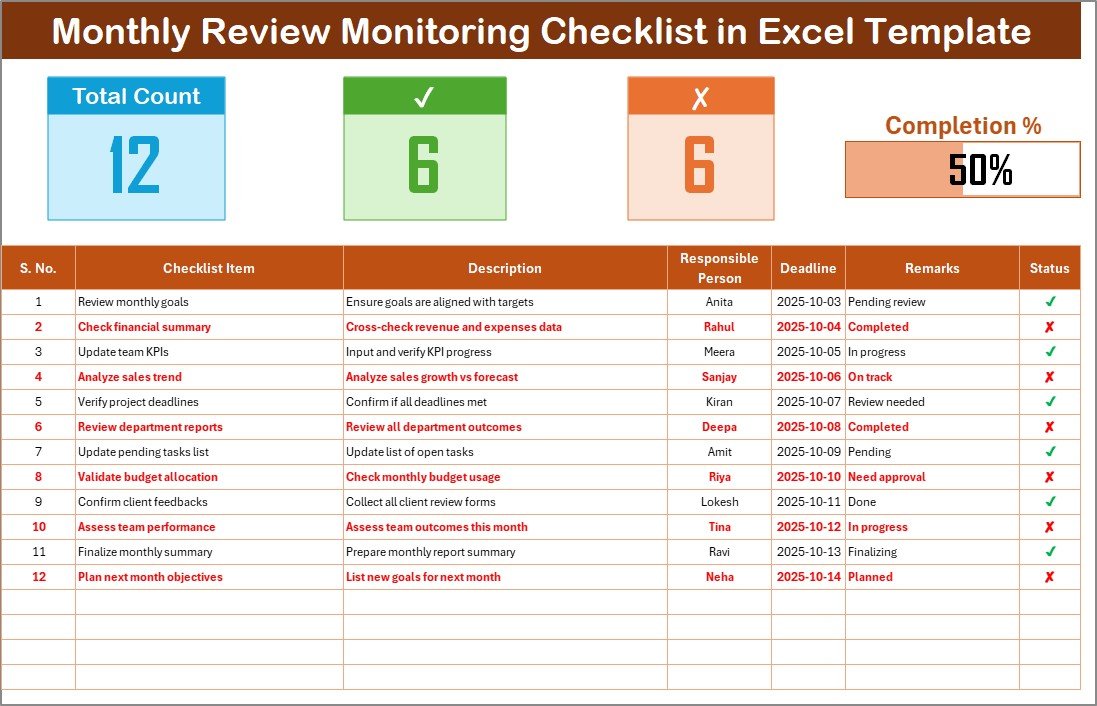
Click to buy Monthly Review Monitoring Checklist in Excel
2. List Sheet Tab
The List Sheet acts as a supporting database for dropdown selections. It stores a unique list of responsible persons, ensuring data consistency in the main checklist sheet.
By using Excel’s Data Validation feature, you can create dropdowns for the “Responsible Person” column.
This approach prevents typing errors and guarantees uniform names across all records.
You can also expand this sheet later to include more data such as departments, categories, or task priorities.
How to Use the Monthly Review Monitoring Checklist Template
Here’s a simple step-by-step guide to help you start using this Excel checklist effectively:
Step 1️⃣: Enter Checklist Items
List all the activities you want to review for the month. For example:
- Team meeting summary preparation
- Client project status update
- Marketing performance report
- Financial reconciliation
Step 2️⃣: Assign Responsibilities
Use the dropdown list to assign each item to the correct team member. This ensures accountability and transparency.
Step 3️⃣: Add Deadlines
Set realistic deadlines for each task to ensure timely completion. Excel’s date format makes it easy to sort and filter by due dates.
Step 4️⃣: Update Status
As the month progresses, update the status column:
- ✔ = Completed
- ✘ = Pending
Step 5️⃣: Review Progress
Watch the progress bar and completion counts update automatically. Use this data in your monthly review meetings to discuss achievements and bottlenecks.
Benefits of Using a Monthly Review Monitoring Checklist in Excel
Using a well-designed checklist provides more than just organization — it brings focus, clarity, and measurable progress to your workflow.
1. Improved Accountability
Every task is linked to a responsible person, which eliminates confusion and promotes ownership.
2. Time Management
Deadlines help prioritize tasks and ensure timely completion, preventing end-of-month chaos.
3. Simplified Review Meetings
All monthly data is ready in one place, making team reviews faster and more focused.
4. Enhanced Productivity
Wth clear visibility into pending and completed tasks, you can quickly identify areas that need attention.
5. Data-Driven Insights
You can convert the data into pivot tables or charts to analyze performance trends over several months.
6. Easy Replication
Duplicate the sheet every month, rename it (e.g., “January 2025”), and continue tracking seamlessly.
How to Automate the Checklist in Excel
Automation can take your checklist to the next level. Here are some ideas:
- Conditional Formatting: Automatically color-code completed or delayed tasks.
- Progress Calculation: Use COUNTIF formulas to calculate percentages dynamically.
- Dashboard Summary: Create a small dashboard with KPI cards (e.g., % Completed, Avg. Delay).
- Dropdown Menus: Use Data Validation to ensure accurate entries.
- Dynamic Charts: Add a monthly trend chart to visualize completion progress.
These simple Excel automations save time and make the checklist feel like a mini dashboard.
Use Cases of Monthly Review Monitoring Checklist
This template suits multiple industries and roles:
Corporate Teams
Track departmental objectives, KPIs, and project milestones.
HR and Admin Teams
Monitor employee reviews, policy updates, and compliance tasks.
Finance and Accounts
Ensure monthly reconciliations, expense approvals, and report submissions are on time.
Educational Institutions
Track academic reviews, faculty meetings, or administrative tasks.
Personal Productivity
Use it to manage personal goals, home projects, or fitness reviews.
The versatility of this checklist makes it valuable for any professional or personal context.
Advantages of Monthly Review Monitoring Checklist in Excel
Let’s summarize the top advantages of using this ready-to-use Excel checklist:
- Centralized Tracking: Monitor all review items from one sheet.
- Monthly Planning Made Easy: Prepare and review plans without manual effort.
- Smart Indicators: Visual progress bars and counts make performance review intuitive.
- Better Collaboration: Dropdown lists streamline responsibility assignment.
- Reusable Format: Copy and modify the same sheet for every new month.
- Error Reduction: Automated formulas reduce manual miscalculations.
- Data Ready for Reports: Easily integrate into dashboards or Power BI for higher-level reporting.
Opportunities for Improvement
Even though the checklist is powerful, there’s always room to enhance it further:
- Add a “Priority” column (High, Medium, Low) for better focus.
- Include automatic alerts for overdue deadlines using conditional formatting.
- Integrate with Power Query or Power BI for advanced insights.
- Add calculated fields such as “Days Remaining” to enhance time tracking.
- Create a summary sheet to show trends month over month.
These improvements make the tool even more interactive and professional.
Best Practices for the Monthly Review Monitoring Checklist
To make the most of this Excel template, follow these practical tips:
- Keep Descriptions Short: Limit text length for readability.
- Assign Every Task: Don’t leave “Responsible Person” blank.
- Update Weekly: Don’t wait until month-end; update as you go.
- Review with Team: Use the checklist in your monthly review meetings.
- Backup Regularly: Keep a copy of each month for performance comparisons.
- Us Convert to Dashboard: Use charts and graphs for an executive summary.
Following these best practices ensures your review process remains efficient and transparent.
Conclusion
A Monthly Review Monitoring Checklist in Excel is more than a spreadsheet — it’s a productivity partner.
It helps you streamline reviews, ensure accountability, and maintain steady progress throughout the year.
By combining structure, automation, and visibility, you can transform routine monthly reviews into a data-driven decision-making process. Whether for teams or individuals, this Excel template ensures every goal, task, and milestone stays on track.
Frequently Asked Questions (FAQs)
1️⃣ What is a Monthly Review Monitoring Checklist used for?
It helps you track monthly tasks, measure completion progress, and evaluate performance for projects, teams, or individuals.
2️⃣ Can I customize this checklist for my department?
Yes. You can easily modify checklist items, add more columns, or change the layout according to your department’s workflow.
3️⃣ How does the progress bar update automatically?
It uses Excel formulas like COUNTIF to calculate completed tasks and converts the result into a progress bar through conditional formatting.
4️⃣ Can I use this checklist for personal tasks?
Absolutely! It works perfectly for tracking personal goals, household chores, or self-development plans.
5️⃣ Is this template compatible with Google Sheets?
Yes, you can upload it to Google Sheets and use similar formulas, though formatting might need minor adjustments.
6️⃣ How often should I update the checklist?
Ideally, update it weekly to maintain real-time accuracy and make monthly reviews more effective.
7️⃣ What if multiple people need access to the file?
Save it on a shared drive like OneDrive or SharePoint, enabling collaborative editing.
8️⃣ Can I generate reports from this checklist?
Yes, you can use pivot tables or charts to summarize monthly performance and visualize completion trends.
9️⃣ How many items should a monthly review checklist include?
There’s no fixed limit. However, keeping it under 25-30 items ensures it stays manageable and effective.
🔟 Can I automate reminders for deadlines?
While Excel alone doesn’t send alerts, you can link it with Outlook or use VBA macros for automated notifications.
Visit our YouTube channel to learn step-by-step video tutorials
Watch the step-by-step video tutorial:
Click to buy Monthly Review Monitoring Checklist in Excel
